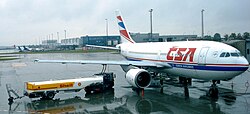Jet fuel
 |
|
| Identifiers | |
|---|---|
|
70892-11-4 (fuel oil no. 5) 8008-20-6 (kerosene) |
|
| Properties | |
| Appearance | Straw-colored liquid |
| Density | 775.0-840.0 g/L |
| Melting point | −47 °C (−53 °F; 226 K) |
| Boiling point | 176 °C (349 °F; 449 K) |
| Hazards | |
| Safety data sheet | [2] [3] |
| NFPA 704 | |
| Flash point | 38 °C (100 °F; 311 K) |
| 210 °C (410 °F; 483 K) | |
|
Except where otherwise noted, data are given for materials in their standard state (at 25 °C [77 °F], 100 kPa).
|
|
|
|
|
| Infobox references | |
Jet fuel, aviation turbine fuel (ATF), or avtur, is a type of aviation fuel designed for use in aircraft powered by gas-turbine engines. It is colorless to straw-colored in appearance. The most commonly used fuels for commercial aviation are Jet A and Jet A-1, which are produced to a standardized international specification. The only other jet fuel commonly used in civilian turbine-engine powered aviation is Jet B, which is used for its enhanced cold-weather performance.
Jet fuel is a mixture of a large number of different hydrocarbons. The range of their sizes (molecular weights or carbon numbers) is defined by the requirements for the product, such as the freezing or smoke point. Kerosene-type jet fuel (including Jet A and Jet A-1) has a carbon number distribution between about 8 and 16 (carbon atoms per molecule); wide-cut or naphtha-type jet fuel (including Jet B), between about 5 and 15.
Fuel for piston-engine powered aircraft (usually a high-octane gasoline known as avgas) has a low flash point to improve its ignition characteristics. Turbine engines can operate with a wide range of fuels, and jet-aircraft engines typically use fuels with higher flash points, which are less flammable and therefore safer to transport and handle.
The first axial compressor jet engine in widespread production and combat service, the Junkers Jumo 004 used on the Messerschmitt Me 262A fighter and the Arado Ar 234B jet recon-bomber, burned either a special synthetic "J2" fuel or diesel fuel. Gasoline was a third option but unattractive due to high fuel consumption. Other fuels used were kerosene or kerosene and gasoline mixtures. Most jet fuels in use since the end of World War II are kerosene-based. Both British and American standards for jet fuels were first established at the end of World War II. British standards derived from standards for kerosene use for lamps—known as paraffin in the UK—whereas American standards derived from aviation gasoline practices. Over the subsequent years, details of specifications were adjusted, such as minimum freezing point, to balance performance requirements and availability of fuels. Very low temperature freezing points reduce the availability of fuel. Higher flash point products required for use on aircraft carriers are more expensive to produce. In the United States, ASTM International produces standards for civilian fuel types, and the U.S. Department of Defense produces standards for military use. The British Ministry of Defence establishes standards for both civil and military jet fuels. For reasons of inter-operational ability, British and United States military standards are harmonized to a degree. In Russia and former Soviet Union countries, grades of jet fuels are covered by the State Standard (GOST) number, or a Technical Condition number, with the principal grade available in Russia and members of the CIS being TS-1.
...
Wikipedia

